| A
Goddess in mycenaean Greece
a-ta-na-po-ti-ni-ja
: At(h)anapotnia , in a Tablet from Knossos ( but there are many other
-potniai-,related to different villages orr buildings , like the "dapuritojo
potinija" / Goddess of the Labyrinth ,still in Knossos ,or to animals too)
|

Statue of Athena in Delphi |
Is it possible
that the Athena of the greek classic world has been in mycenaean times
the Atanapotnia of the tablets in Linear B..? The resemblance of this name
seemed to leave no doubts on her identity , nevertheless philological analysis
makes this identification uncertain . For ancient Greeks and Romans it
was a very natural thought to identify the greek Pallas Athena with the
roman Minerva . Today historians and ethnologists speak about an "indo-european
Pantheon" , but we know that in Mythology and Arts the attributes and the
"appearance" of a "Divinity" often get confused with another one , and
, some popular traditions , with time , overwhelm the "historicity" of
the Religion.
In later centuries , both
, Greeks and Romans ,accepted gladly cults of Gods and Goddesses from exotic
religions in their territory. A very different attitude may have been that
of seafaring ancient Hellens in the Mediterranean Sea : from Homer to the
great Tragicals , we can read how those men found , all over the known
World , temples and altars dedicated , they belived ,to Jupiter , Aphrodites
and many other Gods . They tried , in conclusion , to make other religions
similar to the Greek religion ; and when they did not succeed , considered
those populations as barbarians . |
| ----------- |
We know very little about the Minoan Religion, of the Religion practised in the aegean areas, until the arrival of indoeuropean tribes. We know the places of the cult (caves, peak sanctuaries, special rooms inside the great palaces), the objects of this cult ( the Goddess of the Snakes, of the Animals, may be also living snakes as chtonic [chtonic: from gr.  = earth] presence), the altars, the sacred graves, the Symbols (the double-axes, the consacration horns), maybe we know also something about the rituals (processions and sacrifices), but of the philosophical content, of the -cosmogony- of this cult (surely bound to that of the Mother Earth) nothing until now has been told. In later times only, about the end of the Myceneaean Era, it will be possible, among the classical Deities (Jupiter. Poseidon, Hephestos, Dionysos, maybe Arthemis and other Gods) to recognize some older deities.
It is very difficult
, impossible perhaps , to find in the features of these little clay statues
, the classic ones of the Parthenon or of imperial Rome , and more : rarely
it is possible to say about these representations , which one are goddesses
and which priestresses (we know from the Documents the mycenaean culture
left , that they existed ) = earth] presence), the altars, the sacred graves, the Symbols (the double-axes, the consacration horns), maybe we know also something about the rituals (processions and sacrifices), but of the philosophical content, of the -cosmogony- of this cult (surely bound to that of the Mother Earth) nothing until now has been told. In later times only, about the end of the Myceneaean Era, it will be possible, among the classical Deities (Jupiter. Poseidon, Hephestos, Dionysos, maybe Arthemis and other Gods) to recognize some older deities.
It is very difficult
, impossible perhaps , to find in the features of these little clay statues
, the classic ones of the Parthenon or of imperial Rome , and more : rarely
it is possible to say about these representations , which one are goddesses
and which priestresses (we know from the Documents the mycenaean culture
left , that they existed ) |
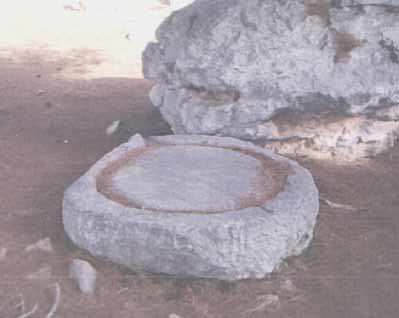
A platform for sacrifices by the acropolis of Tyrins |
|
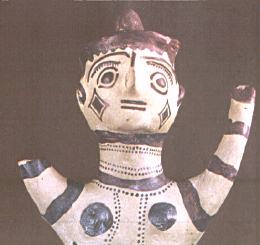
|

|
| One
of the "Idols" , recovered in Mycenae in a cult area , and a picture of
the temple where that was found . The site seems to have been abandoned
, already before the collapse of the city. |
|
It is intresting
to see how,from one side, in the texts mostly men are cited as bearer of
an official charge (wanax, lawagetas., damokoros), and from the other side,
in the frescos mostly women are frescoed, related to religious functions.
There are also "idols" of male sex, but they are of very rough making.
In the picture on the left
a Priestress (or more probably, a Princesse, because of her hat) from Mykenae. But, according to the opinion of J.Chadwick, in his book -The World of the Mycenaeans-, that could be just the representation of a -potnia- as a Goddess -protectress of the contiguous smithy. And last, according to L.Godart, it could be a representation of Demetra, the Mother Earth, holding in her hands spikes of wheat. |

|
| From a theban tablet of the end of the XIII century b.C. (TH Fq126) it is possible to find a continuity between the cult of the Mycenaean Greece and the classical one, an overlapping. Here the text of the tablet:

|
The text, literally translated
(see nota ) means: when (ote)
has been made (teto) the offering (tuwo) to the Mother Earth (ma-ga)
of T1 quantities of barely (ideogram of barely) and V1 to [Jupiter]
bearer of fruits (oporei) of V1 Z2 and to the girl (kowa)
[Persephone, Proserpina] V. Three Deities
(they are indeed a Triade, portrayed in a beautiful ivory group from Mycenae) are recipient of the offering, of these ones, Jupiter belongs to the indoeuropean tradition and another one, the Ma Ga, Demeter, the Mother Earth, belongs to the cults of the neolithic revolution of agricolture in the Mediterranean: then a coexistence of both traditions, during until the historical Greece with a slow prevailing of the indoeuropean religion.
|
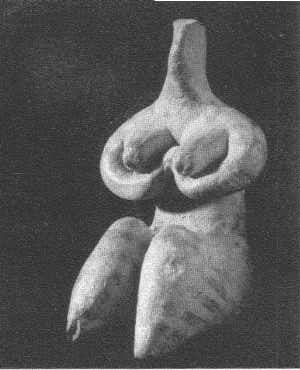
A statue representing the Mother
Goddess,from Tell Halaf (Syria).
|
|
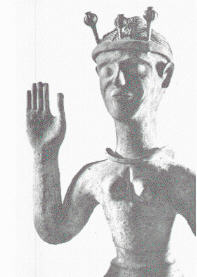
A Goddess with
Poppies (Crete) |
----------------------------------------------
..last end , maybe , the only side of the Greek religion we can today study and
admire is only the *apollinean one : the original form , much more
true and near the ancient mediterranean cults , still remains hidden in
the mysteries of the *dionisian and orgiastic rituals , which better
could agree with the dramaticity and the "color" of some images .
* : according to the definition
of the german philosopher Nietzsche , the greek art could be divided
into two categories : the apollinean Art , like sculpture : the art of
the equilibrium of the shapes , of the calm and waiting . And then the
dionisian Art : music first , but also that one of the vascular painting
: that one of the excessivenesses , of the drunkenness of the Eros and
the Menads . And also , (given the frequency of such kind of images ) may
be Poppy was not only a "flower" .
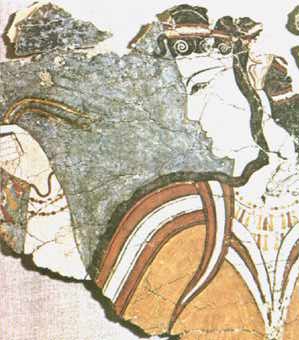
The goddess and the
snake (Mykenae, XIII b.C.)
|
|
|
 Why did the Lions..?
Why did the Lions..? |
 The
Writing of the Mycenaeans The
Writing of the Mycenaeans |
 Aristocracy,
pirates and.. Aristocracy,
pirates and.. |
 Foto
dal Mediterraneo Foto
dal Mediterraneo |
 back
to main page back
to main page |
|
La foto dell' area di culto
cosi' come alcuni concetti generali sono stati ripresi dal libro I Micenei
(The Mycenaeans) / Taylour L. William
Per l' aspetto "filologico"
del problema mi sono basato principalmente sul libro Die fruehgriechischen
Texte aus mykenischer Zeit di S. Hiller e O. Panagl |
This page hosted by  Get your ownFree Home Page
Get your ownFree Home Page
|
|
|
nota
Following the transcription of the text in classic greek, but the true pronunciation is not sure:
 Back to The text literally.. Back to The text literally..
|










